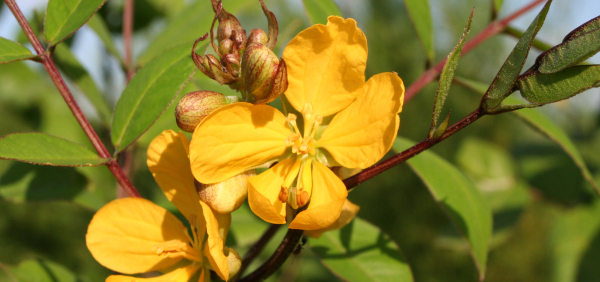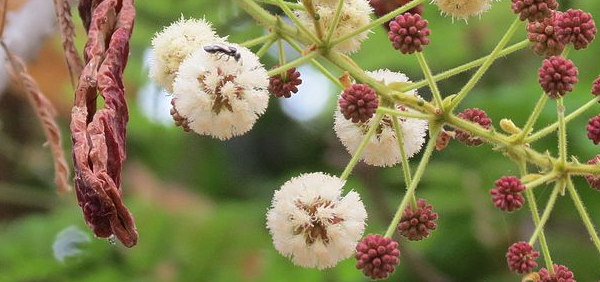mishamitika :
 Goldthread, also known as coptis or canker root, is a genus of perennial herbs that have been part of Asian and North American traditional medicine for hundreds of years. The roots of the plant look like a tangled mass of gold thread, hence its name. Herbal goldthread is actually the powdered rhizome, or underground stem, of the goldthread plant.
Goldthread, also known as coptis or canker root, is a genus of perennial herbs that have been part of Asian and North American traditional medicine for hundreds of years. The roots of the plant look like a tangled mass of gold thread, hence its name. Herbal goldthread is actually the powdered rhizome, or underground stem, of the goldthread plant.HISTORICAL AND MYTHOLOGICAL REVIEW:
This herb was recorded as early as 1825 by R. Wilcox and Captain Bedford
followed by Griffith in 1836 from Mishmi Hills of Indian flora.
Mishmis and other tribes of Arunachal Pradesh used C. teeta to treat
malaria, stomach ache and dysentery.
Taxonomical Classification
Kingdom: Plantae - Plants
Subkingdom: Tracheobionta - Vascular plants
Superdivision: Spermatophyta - Seed plants
Division: Magnoliophyta - Flowering plants
Class: Magnoliopsida - Dicotyledons
Family: Ranunculaceae
Genus: Coptis
Species: Coptis teeta
Allied species:
Coptis teetoidesVERNACULAR NAMES
Sanskrit: Mamira, Mamirah, Mishamitita, Mishamlita, Pita, Pitamula, Supita, Tikta, TiktamulaEnglish: gold thread
Hindi: Haladiya bachnaga, Mahamirana, Mamira, Mamiram, Mamiran, Mimira, Mishmitita
Urdu: Mameeran, Mameesa (mamira, Mamiran), Mamiran-i-chini, Mamira
Bengali: Mahanim, tita
Marathi: pitmula haldiya bachnag,
Gujarathi: Mamria
Tamil: Pitarohini, Pitarokini, Peetarogini, Pidarokini, Mamiran
Malayalam: Pitarohini
Kannada: vishateetee, priyaaranga
Punjabi: Chireta
Sindhi: Mahmira
Arabic: Mamira -chini
Assamese: Tita
Chinese: 雲南黃連)
French: coptis
Persian: Mamiran-e-Chini
Sinhalese: Pitakarosan
Definition
Coptis teeta is a rare species of flowering plant in the buttercup family.Synonyms
Synonyms in Ayurveda: mamira, pitmulaTikta mula- root is bitter in taste
Rasa: Tikta
Guna: Ruksha
Veerya: Ushna
Vipaka: Katu
Karma: Depana Kaphahara Pachana Pittahara Vatahara
It is a species of importance in Chinese herbology. Known as Yunnan goldthread (Chinese: 雲南黃連), its rhizome is used as an antimicrobial and anti-inflammatory.
Cultivation:
Succeeds in a light moist humus-rich slightly acidic soil with a northerly aspect or light shade
This plant is cultivated in a small scale with the aim to conserve it in its natural habitat.
Arunachal Pradesh Forest department has taken up cultivation of this plant in small pockets of Dibang Valley and Lohit districts.
The local people have also taken up cultivation of this plant species in some places of Arunachal
Pradesh. Outside Arunachal Pradesh, it is reported to be cultivated on small scale in certain areas of adjoining districts of Nagaland.
Propogation:
Seed - best sown in a greenhouse as soon as it is ripe in an ericaceous compost
Seal the pot in a polythene bag until germination takes place, which is usually within 1 - 6 months at 10°c
Stored seed should be sown as early in the year as possible. Four weeks cold stratification may be beneficial
Prick out the seedlings into individual pots when they are large enough to handle and grow on in a shady part of the greenhouse for at least their first winter. Plant them out in mid-autumn or in spring.
Division in spring
Harvesting:
Flowering and fruiting -February - April
Collection of rhizomes is done from September onwards before snow fall. The rhizomes are dried in the Sun for a week and then sold in the market. Well-dried rhizomes can be stored and used for a maximum of twenty years.
Phytochemistry:
Rhizome contains a number of alkaloids such as palmatine, berberine, epiberberine and jatrorrhizine.PHARMACOLOGY:
Important formulations1. Karpooradi kuzhambu
Parts used for medicinal purpose
Root, Underground rhizomes, ,Dosage:
churna 1 - 3 gmTincture - 2.5 ml- 5 ml
Infusion - 28-56 ml
Substitute:
The rootstock of Geranium wallichianum D. Don ex Sweet (Geraniaceae) is used as a substitute for Coptis teeta. The root of Thalictrum filiolosum DC. (Ranunculaceae) is also used as a substitute and adulterant to C. teeta.Adultrants:
Since the roots of the species of the genus Swertia resemble rhizomes/roots of C. teeta, in appearance, they are adulterated with this speciesControversy:
Some consider Thalictrum foliolosum as mamiraCommercial value:
Current rate of Coptis teeta is about Rs.2000/kg,Morphology:
Small stemless herbs.
Rootstock: horizontal, perennial, golden yellow, woody, densely fibrous, very bitter.
Leaves: ternatisect, glabrous,
Petioles: 6-12 in.;
Leaflets: 2-3 in., ovate-lanceolate, pinnatiiid, lobes incised, terminal largest.
Scape: equalling the leaves.
Flowers: 1-3—pedicelled, regular, small, white on slender leafless scapes.
Bracts: leafy.
Sepals: 5-6, ½ in. oblong—lanceolate, acute.
Petals: 5-6, narrow, ligulate, obtuse, ⅔ shorter than the sepals.
Carpels pedicelled, spreading.
Ovules many.
Follicles many-seeded. Seeds with a black crustaceous testa. Mishmi nuts, Bengal.
Histology:
Its interior is yellow–orange; in the transverse section, the central pith is deeper in color.Geographical distribution:
E. Asia - N. China to the temperate regions of the Himalayas.ECOLOGICAL ASPECT:
This herb grows at the lower elevation limit of 1700 mts and upper elevation limit of 2800 mts.Plant conservation:
This herb is enlisted in Red List Category as endangered (A2cd ver 3.1) (IUCN Red List of threaneted species).General Use:
The root is a pungent, very bitter, cooling herb that controls bacterial and viral infections, relaxes spasms, lowers fevers and stimulates the circulation. It is locally analgesic and anaesthetic and is used in Chinese medicine as a general panacea with alterative, ophthalmic and pectoral activity. The root contains several compounds that are effective in inhibiting various bacteria and they are a safe and effective treatment for many ailments, such as some forms of dysentery, that are caused by bacteria. The root is harvested in the autumn and can be used fresh or driedTherapeutic Uses:
This plant is bitter, cooling and a potent bacterostatic herb. The dried rhizomes of this plant constitute the raw drug. The raw drug contains major active compounds berberine and coptine. In action, the drug is antidiabetic, bitter tonic, carminative, expectorant, febrifuge, ophthalmic and stomachic.Systemic Use:
It is used for the treatment of various types of fevers, debility after fever, dysentery, nausea, jaundice, flatulence and visceral obstruction, haemorrhages (either from dysentery or from haemoptysis), conjunctivitis, nervous diseases, eye troubles, appetiser, constipation, indigestion, dyspepsia, asthma and cough. It is also reported to relieve toothache. It is a very much useful in malarial fever. It is used as general all-round tonic.Administration:
The remedy is applied in form of extract, infusion, powder, eye salve, or paste.Pharmacological:
It is a bitter tonic, useful in fevers and atonic dyspepsia.Clinical trials:
1. Chauhan A, Goyal MK, Chauhan P. GC-MS Technique and its Analytical Applica-tions in Science and Technology. J Anal Bioanalytical Tech. 2014;5(6):222. doi: 10.4172/2155-9872.1000222.2. Ye Jiesheng. Application of gas chromatography-mass spectrometry in research of traditional Chinese medicine: Chemical Papers. 2009;63(5):506-1
Research:
1. Distribution, Ethnobotany, Pharmacognosy and Phytoconstituents of Coptis teeta Wall.: A Highly Valued and Threatened Medicinal Plant of Eastern Himalayas - Temin PayumPrecautions:
Berberine is known to cause contractions of the uterus in laboratory animals. For this reason, it is recommended that pregnant women not take coptis or any other herb containing berberine.Children: Goldthread is UNSAFE in children. It contains a chemical called berberine that can increase the amount of bilirubin in newborns. Bilirubin is a chemical released by the liver. Too much bilirubin can lead to permanent brain damage in newborns, especially in newborns born too early.
Toxicity studies:
There is not enough information to know if goldthread is safe in medicinal amounts. Goldthread is UNSAFE in newborn infants.Use in other system of medicine:
In China used as antidiabeticCONCLUSION:
Coptis teeta is a perennial, herbaceous plant, reportedly endemic to Arunachal Pradesh. The
rhizome of Coptis teeta is the medicinally important part as it produces a bitter principle,
which is useful as a tonic and febrifuge, especially in intermittent fever. The plant has
applications in Ayurveda, Unani and Sidha systems of medicine. Unsustainable, commercial
exploitation of the plant for international trade is the main reason for its critically
endangered status. The species is also categorized within the list of banned export item
unless accompanied by a certificate of origin. The state forest department of Arunachal
Pradesh has taken some steps to protect the species by in situ conservation in Namdhapa
Biosphere Reserve.
Photos of mishamitika -
- Courtesy: https://08511630493324166816.googlegroups.com/attach/30fc98483fa24/_DSC0746.JPG?part=0.2&view=1&vt=ANaJVrGFTNxVVbporlQV2SFLuSxSaqVvBzUETIuRVUlXQgrMOXwQh8tFtvkLpme6xLVqwWyUfznxVFQAspDsSXZff1kLsH723sX1HvlCQGMdl6onfgsGksY
- Courtesy: https://www.iucnredlist.org/species/50126583/50131320
- Courtesy: https://www.iucnredlist.org/species/50126583/50131320
- Courtesy: https://08511630493324166816.googlegroups.com/attach/30fc98483fa24/_DSC0748.JPG?part=0.4&view=1&vt=ANaJVrE4fHSS-M1Mxl1TuFlBx6JAeU48NIx6IAF8PoF8jQL0dTu5-9a_SKCqOEgf8sXqI8VQBW110DV6PVhYj-8dO1qyfovvwpPwFflqQ-yFepXi0oNlKOU
- Courtesy: http://plantillustrations.org/species.php?id_species=272814
KEY WORDS: mishamitika Coptis teeta Wall. Mamira
- » Classification and names of mishamitika
- » Synonyms and definitions of mishamitika
- » Drug Properties of mishamitika
- » Chemical Constituents of mishamitika
- » Standardization of mishamitika
- » Parts used and Dosage of mishamitika
- » Morphology and Histology of mishamitika
- » Distribution and Conservation of mishamitika
- » Cultivation of mishamitika
- » mishamitika in the market
- » Medicinal Uses of mishamitika
- » Researches and clinical trails of mishamitika
- » mishamitika in other sytems of medicine
- » Ayurvedic formulations with mishamitika
- » Images of mishamitika

Kotakkal Ayurveda - Mother land of modern ayurveda
















